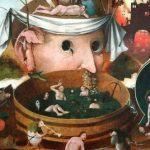 Technology
Technology  Technology
Technology  Humans
Humans 10 Everyday Human Behaviors That Are Actually Survival Instincts
 Animals
Animals 10 Animals That Humiliated and Harmed Historical Leaders
 History
History 10 Most Influential Protests in Modern History
 Creepy
Creepy 10 More Representations of Death from Myth, Legend, and Folktale
 Technology
Technology 10 Scientific Breakthroughs of 2025 That’ll Change Everything
 Our World
Our World 10 Ways Icelandic Culture Makes Other Countries Look Boring
 Misconceptions
Misconceptions 10 Common Misconceptions About the Victorian Era
 Mysteries
Mysteries 10 Strange Unexplained Mysteries of 2025
 Miscellaneous
Miscellaneous 10 of History’s Most Bell-Ringing Finishing Moves
 Technology
Technology Top 10 Everyday Tech Buzzwords That Hide a Darker Past
 Humans
Humans 10 Everyday Human Behaviors That Are Actually Survival Instincts
 Animals
Animals 10 Animals That Humiliated and Harmed Historical Leaders
Who's Behind Listverse?

Jamie Frater
Head Editor
Jamie founded Listverse due to an insatiable desire to share fascinating, obscure, and bizarre facts. He has been a guest speaker on numerous national radio and television stations and is a five time published author.
More About Us History
History 10 Most Influential Protests in Modern History
 Creepy
Creepy 10 More Representations of Death from Myth, Legend, and Folktale
 Technology
Technology 10 Scientific Breakthroughs of 2025 That’ll Change Everything
 Our World
Our World 10 Ways Icelandic Culture Makes Other Countries Look Boring
 Misconceptions
Misconceptions 10 Common Misconceptions About the Victorian Era
 Mysteries
Mysteries 10 Strange Unexplained Mysteries of 2025
 Miscellaneous
Miscellaneous 10 of History’s Most Bell-Ringing Finishing Moves
10 Books That Inspired Dark Behaviors
We all love a good book, and, if we’re honest, most of us Harry Potter fans would admit to waving a stick around while channeling our inner “Boy Who Lived.” Not all examples are as magical, however. While novels and works of fiction often inspire creativity and empathy, some readers interpret certain stories in ways that lead to bizarre behavior.
These ten cases highlight moments when fictional worlds spilled into reality, with individuals claiming that novels or characters drove them to commit extraordinary, often gruesome, acts. Whether a misunderstood hero or a macabre philosophy, these influences reveal the immense and sometimes unpredictable power of the written word.
Related: 10 Books Bound in Human Skin
10 Dracula by Bram Stoker: Richard Trenton Chase
Published in 1897, Dracula introduced the modern vampire myth, immortalizing Count Dracula as a figure who survives by drinking human blood. The novel’s dark allure captivated audiences, embedding the idea of vampirism deeply into popular culture. Decades later, this obsession would resonate disturbingly with Richard Trenton Chase, the “Vampire of Sacramento,” who carried out grisly murders between 1977 and 1978.
As a child, Chase was known to kill animals and even consumed the blood of birds. Chase, suffering from severe mental illness, believed that his own blood was vanishing and that he could only survive by drinking fresh blood. He murdered six people, drinking their blood and even eating parts of his victims.
When police arrested Chase, they discovered his home was covered in human blood, with traces found in the blender and sinks, indicating he had been drinking it over a period of time. In 1979, Chase went to trial, where his attorney argued he was legally insane. However, the jury found him sane, convicting him on six counts of first-degree murder and sentencing him to death. Chase later took his own life in his cell at San Quentin on December 26, 1980.[1]
9 The Catcher in the Rye by J.D. Salinger: Mark David Chapman
J.D. Salinger’s The Catcher in the Rye, published in 1951, became a symbol of teenage alienation, with its protagonist Holden Caulfield embodying a disdain for society’s “phoniness.” For most readers, Holden’s frustrations were relatable musings on growing up, but for Mark David Chapman, the novel became a dangerous obsession.
In 1980, Chapman assassinated John Lennon outside the Dakota building in New York, claiming that he viewed Lennon as the epitome of the phoniness Holden loathed. To Chapman, Lennon’s wealth and fame clashed with his message of peace, turning him into a target of misguided righteousness. Chapman carried a copy of The Catcher in the Rye with him on the night of the murder, inscribing it with the chilling words, “This is my statement,” signed with Holden Caulfield’s name.
After the shooting, he calmly read the book while waiting for the police to arrive. During his trial, Chapman repeatedly referenced the novel, framing it as his justification for killing Lennon. This act turned Salinger’s celebrated work into an infamous touchpoint in one of the most shocking crimes of the 20th century. While The Catcher in the Rye remains a literary classic, its association with Lennon’s murder is a grim reminder of how art can be dangerously misconstrued.[2]
8 The Sorrows of Young Werther by Johann Wolfgang von Goethe
First published in 1774, Goethe’s The Sorrows of Young Werther chronicles the emotional agony of Werther, a young man hopelessly in love with a woman he can never have. Werther’s heartbreak leads him to take his own life, culminating in a romanticized depiction of despair. The novel resonated deeply with young readers across Europe, sparking what became known as “Werther Fever.”
Admirers imitated Werther’s melancholic persona, donning his distinctive attire and quoting his passionate soliloquies. However, the novel’s depiction of suicide inspired a wave of copycat deaths, leading to its censorship in several countries. The phenomenon surrounding The Sorrows of Young Werther marked one of the first instances of “contagion suicide,” where media portrayal leads to imitation. Sociologist David Phillips later coined the term “Werther effect” in 1974 to describe this tragic pattern.
Goethe’s work, while celebrated for its literary brilliance, sparked an ethical debate about the responsibility of authors in presenting sensitive topics like suicide. The legacy of Werther serves as both a testament to the power of storytelling and a cautionary tale about its unintended consequences. Its historical impact remains a sobering reflection on the influence of art over vulnerable minds.[3]
7 Thus Spoke Zarathustra by Friedrich Nietzsche: Leopold & Loeb
Friedrich Nietzsche’s Thus Spoke Zarathustra challenges readers with its provocative ideas about morality and the concept of the Übermensch, or “Superman,” who transcends traditional ethical norms. While the philosophy intended to inspire individual greatness, it took a dark turn in 1924 when Nathan Leopold and Richard Loeb, two privileged University of Chicago students, brutally murdered 14-year-old Bobby Franks.
Viewing themselves as Nietzschean Übermenschen, Leopold and Loeb sought to commit the “perfect crime” to prove their intellectual superiority and freedom from moral constraints. During their trial, their defense argued that their interpretation of Nietzschean philosophy contributed to their warped reasoning. The case shocked the nation, not only because of its brutal nature but because it highlighted how academic ideas could be twisted into a justification for heinous acts.
The murder—and their use of Thus Spoke Zarathustra to rationalize it—remains a chilling example of how philosophical theories can be dangerously misinterpreted when stripped from their context. Nietzsche’s work, though celebrated for its depth and innovation, is often shadowed by its misuse in this infamous crime.[4]
6 First Blood by David Morrell: Michael Ryan
David Morrell’s First Blood introduced the world to John Rambo, a troubled Vietnam veteran turned vigilante who battles against perceived injustices. While Rambo’s struggles symbolize the trauma and alienation faced by veterans, the character’s survivalist ethos became a cultural archetype for lone-wolf rebellion. For Michael Ryan, this persona served as a dark inspiration.
In 1987, Ryan launched a horrific shooting spree in Hungerford, England, killing 16 people. Ryan’s obsession with First Blood and its iconic protagonist was evident in his behavior, from stockpiling weapons to adopting Rambo’s combative demeanor. Dressed in military-style gear, Ryan terrorized his community, moving through the town with the precision of a trained soldier. Witnesses described his chilling calm as akin to a character enacting a script.
After the massacre, investigators found that Ryan had modeled much of his persona on Morrell’s creation, underscoring how the fictional Rambo had become a dangerous figure for the unstable. The Hungerford massacre, one of the worst in British history, sparked debates about media violence, gun control, and the influence of fictional characters on real-world actions. First Blood remains a poignant reminder of how cultural symbols can have unintended consequences when idolized by the wrong individuals.[5]
5 Rage by Stephen King: Michael Carneal
Stephen King’s Rage, written under the pseudonym Richard Bachman, explores the disturbing mindset of a disaffected teenager who commits a school shooting. First published in 1977, the book initially attracted little controversy, but its legacy became grimly infamous after it was linked to real-life tragedies. Among these was the 1997 Heath High School shooting in Paducah, Kentucky.
Fourteen-year-old Michael Carneal opened fire on a prayer group, killing three students and injuring five. Authorities later discovered Rage in Carneal’s locker, leading to speculation that the book may have influenced his actions. The connection between Rage and multiple school shootings led King to take the unprecedented step of pulling the book from print in 1997. King acknowledged the novel’s potential to resonate with troubled youths, emphasizing the author’s responsibility to prevent harm.
While King expressed doubt that Rage directly caused the shootings, he admitted its themes might have provided a dangerous outlet for alienated readers. The controversy surrounding Rage remains a sobering case study of how fictional works can intersect with real-life violence, forcing society to grapple with the ethical responsibilities of creators.[6]
4 Frankenstein by Mary Shelley: Robert Cornish
Mary Shelley’s Frankenstein is a cornerstone of Gothic literature, grappling with the ethical dilemmas of scientific ambition. Its protagonist, Victor Frankenstein, creates life through forbidden experimentation, a theme that captivated Robert Cornish, an American scientist in the 1930s. Inspired by Shelley’s exploration of reanimation, Cornish pursued his own experiments to revive the dead.
Using euthanized dogs, he developed a mechanical “teeterboard” to circulate blood and administered chemical injections, including anticoagulants and adrenaline, to jumpstart vital functions. Some of his canine subjects reportedly regained life, though they suffered serious impairments such as blindness and neurological damage. Cornish’s fixation on reanimation didn’t stop at animals. He petitioned for the chance to apply his methods on human cadavers, even proposing experiments on death-row inmates.
His efforts sparked public outrage and ethical debates, mirroring the moral quandaries Shelley dramatized in her novel. While Cornish’s ambition to defy mortality echoed Victor Frankenstein’s hubris, the grotesque consequences of his work highlighted the perils of overreaching science. Frankenstein remains a timeless cautionary tale, and Cornish’s eerie experiments serve as a real-world example of how its themes can inspire—and distort—human ambition.[7]
3 The Secret Agent by Joseph Conrad: Ted Kaczynski (The Unabomber)
Joseph Conrad’s The Secret Agent is a dark exploration of terrorism and modernity, offering a psychological portrait of anarchists and their destructive ideals. Published in 1907, the novel struck a chord with Ted Kaczynski, a math prodigy turned domestic terrorist known as the Unabomber. Kaczynski’s 20-year campaign of terror involved sending homemade bombs to academics, executives, and other targets he associated with technological advancement.
His manifesto, “Industrial Society and Its Future,” echoed themes from Conrad’s novel, railing against modern society’s dehumanizing effects and championing individual rebellion. Kaczynski’s attacks killed three people and injured dozens, leaving the nation in fear until his capture in 1996. His affinity for The Secret Agent stemmed from its portrayal of the alienation and violence bred by industrial progress, aligning with his personal vendetta against technology.
Conrad’s novel, while a literary masterpiece, unwittingly became a touchstone for Kaczynski’s radical ideology. The Unabomber case underscored how complex works of art can be misinterpreted by individuals seeking validation for their actions, turning profound commentary into justification for terror.[8]
2 Jack Sheppard by William Harrison Ainsworth: Bernard François Courvoisier
William Harrison Ainsworth’s Jack Sheppard captivated Victorian readers with its dramatization of the life of a real 18th-century thief. Sheppard is portrayed as a cunning anti-hero whose daring escapades and rebellious nature made him a folk legend. For Bernard François Courvoisier, a Swiss valet in 1840, the novel’s glorification of criminality proved dangerously inspirational.
Courvoisier murdered his employer, Lord William Russell, claiming later that Ainsworth’s work encouraged him to emulate Sheppard’s defiance of authority. The murder caused public outrage and fear, particularly among the upper class, who worried about the novel’s influence on their servants. Ainsworth’s portrayal of Sheppard as a charming rogue was scrutinized, and Jack Sheppard was criticized for romanticizing lawlessness.
The case fueled debates about the role of literature in shaping behavior, especially among impressionable audiences. While the novel cemented Ainsworth’s reputation as a leading writer of the time, its association with Courvoisier’s crime remains a chilling example of how fiction can be misinterpreted with fatal consequences.[9]
1 The Satanic Bible by Anton LaVey: Richard Ramirez
Anton LaVey’s The Satanic Bible, first published in 1969, introduced readers to the tenets of modern Satanism, emphasizing individualism, hedonism, and the rejection of traditional morality. Richard Ramirez, the infamous “Night Stalker,” took these principles to horrifying extremes. During his mid-1980s killing spree, Ramirez committed a string of brutal murders, often invoking Satan and leaving occult symbols at crime scenes.
Ramirez cited The Satanic Bible as a major influence, claiming its teachings guided his actions. His crimes, which included sexual assault, burglary, and murder, terrorized California and captivated national media. His courtroom appearances only amplified the horror, as he displayed pentagrams and declared allegiance to Satan. While LaVey’s work is often viewed as philosophical rather than incitement to violence, Ramirez’s interpretation twisted its messages into a justification for his heinous acts.
The case sparked widespread moral panic about Satanism and its perceived links to crime, drawing The Satanic Bible into the cultural spotlight. Ramirez’s actions remain a dark testament to how ideologies—real or misunderstood—can fuel destructive behavior.[10]








